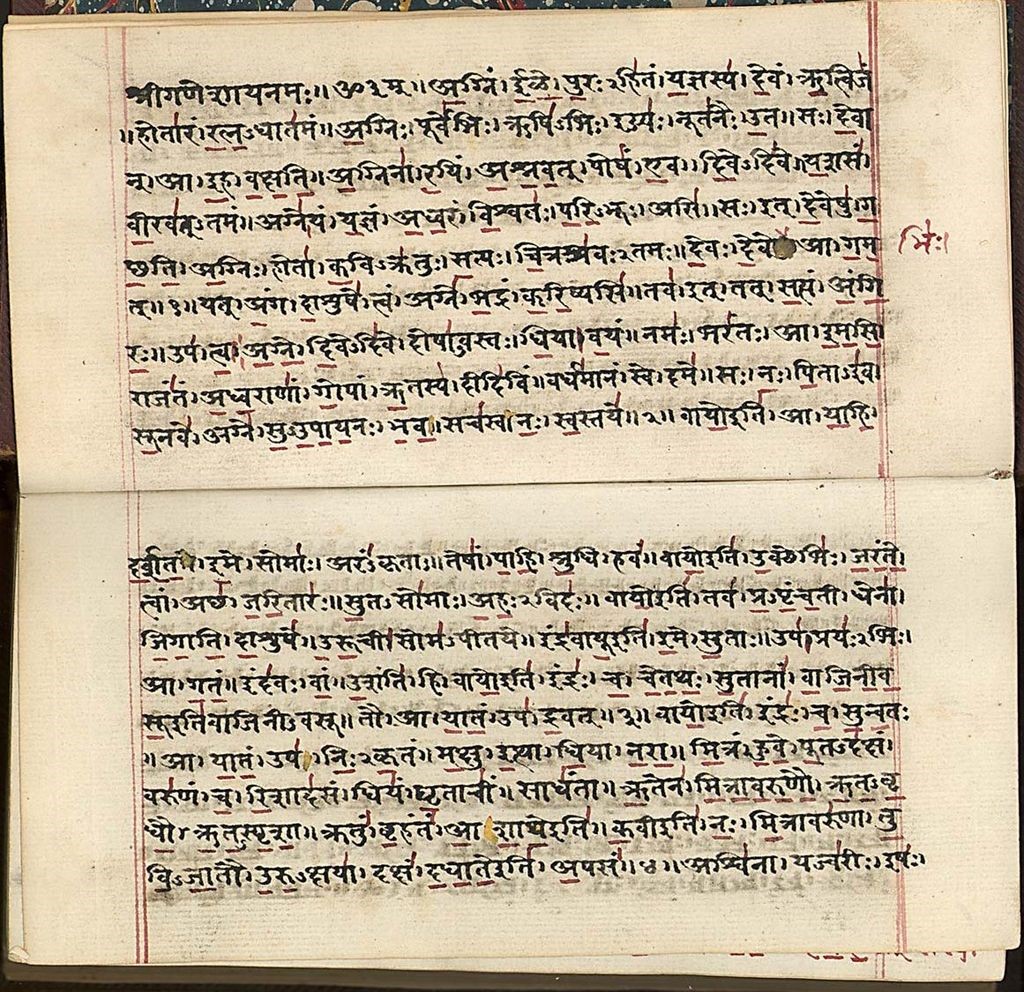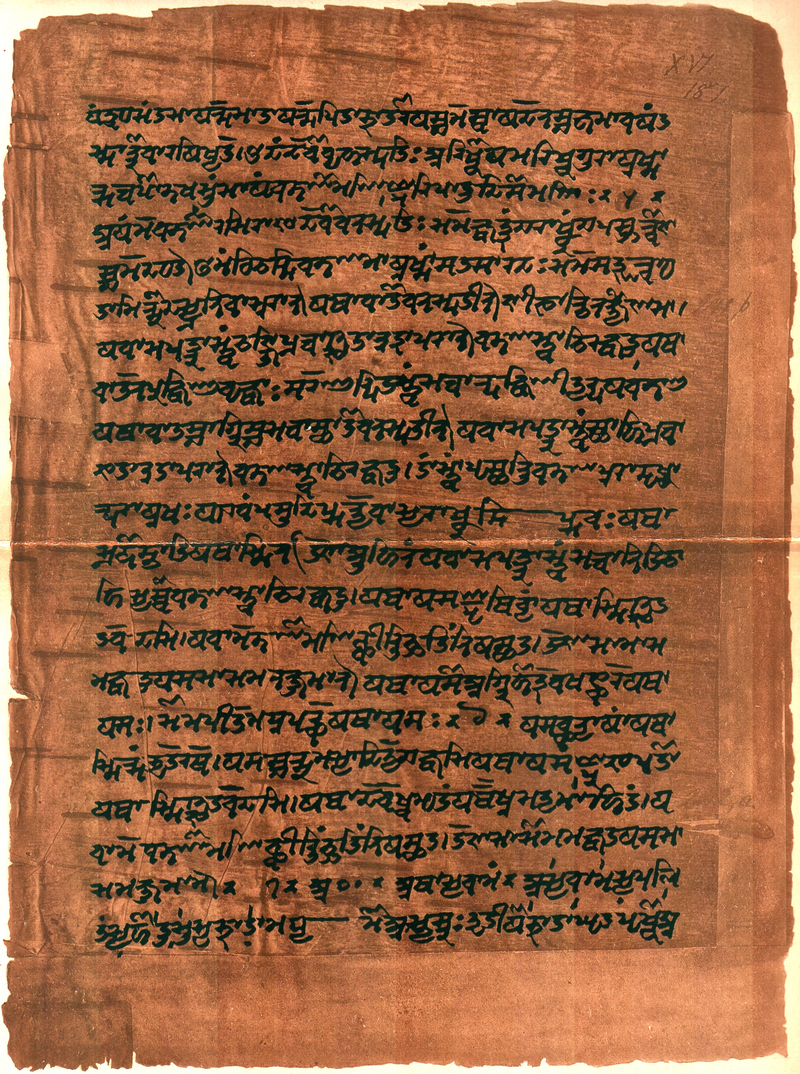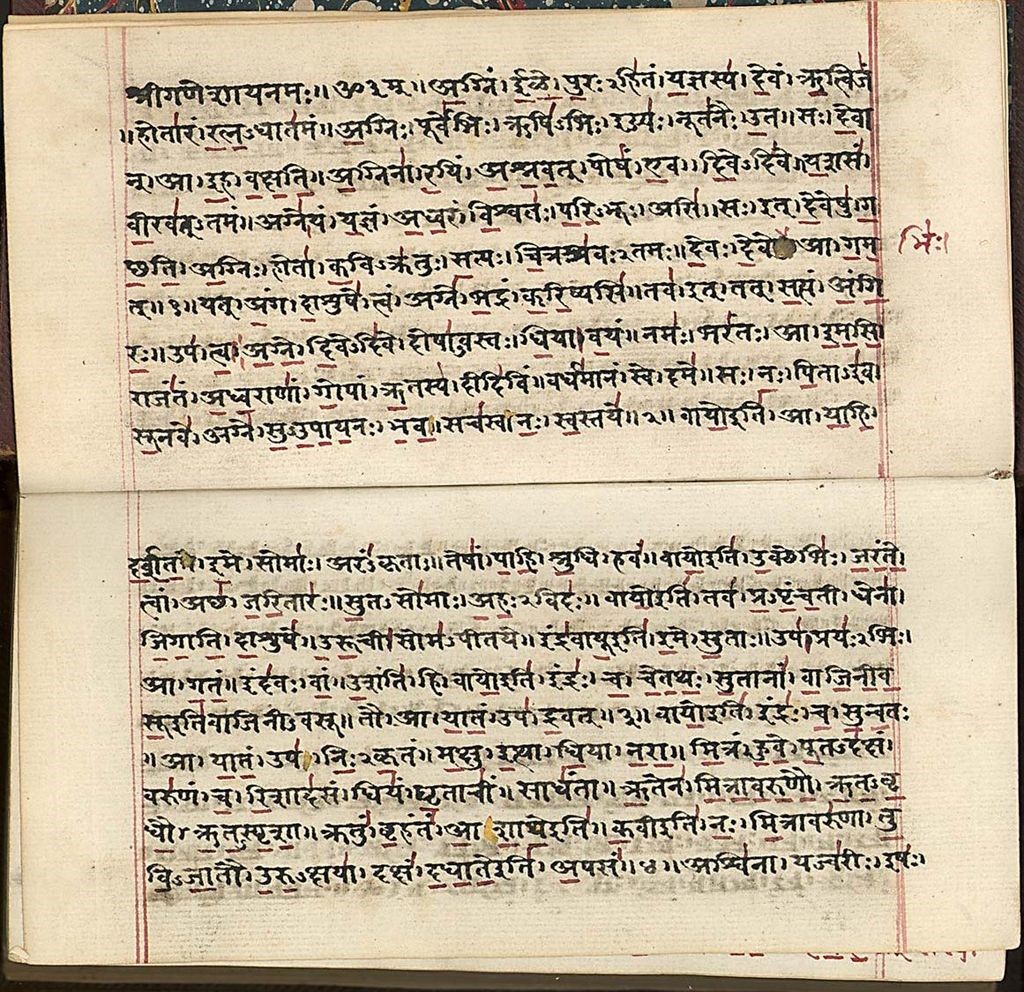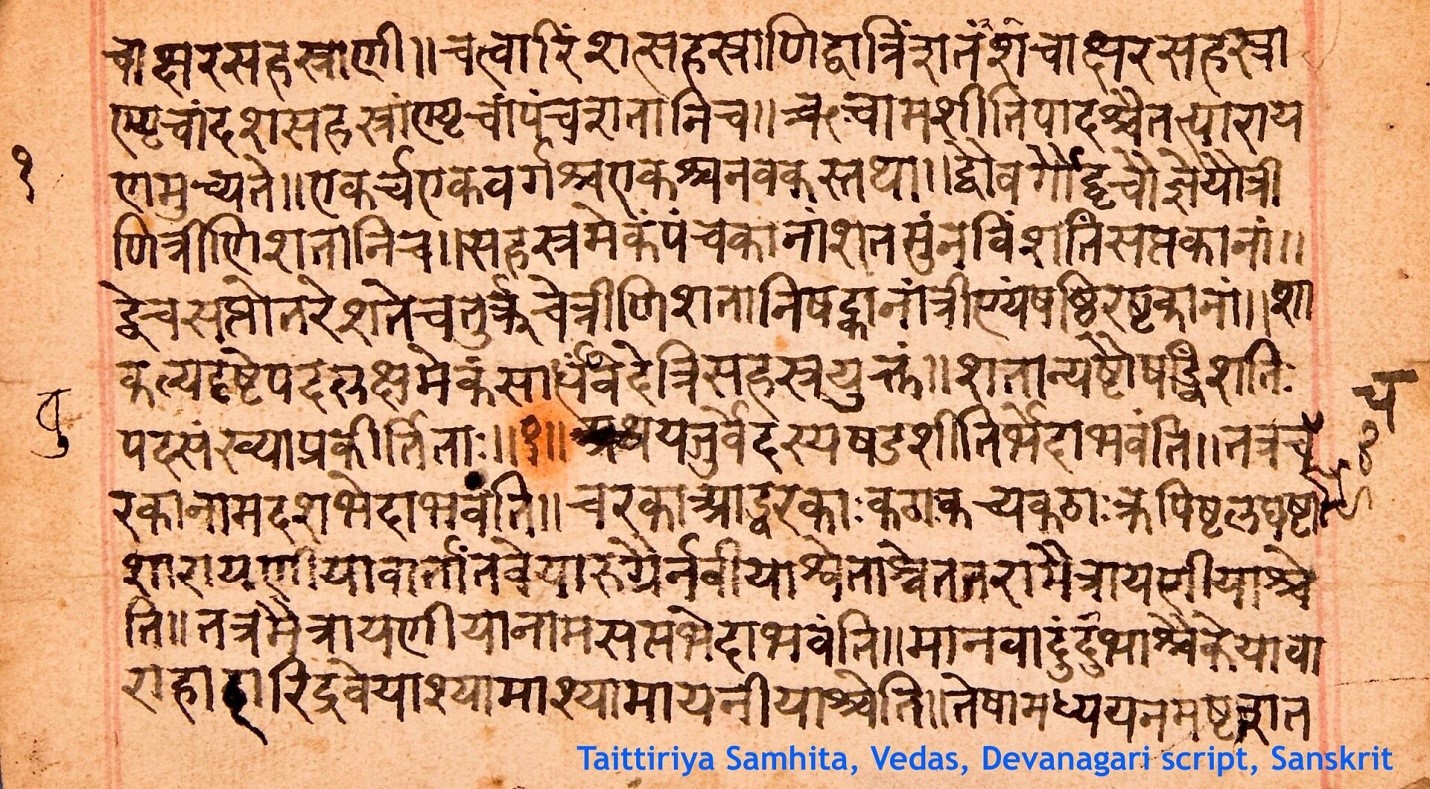VEDAS

(Source)
The Vedas are the religious texts which inform the religion of Hinduism (also known as Sanatan Dharma meaning “Eternal Order” or “Eternal Path”). The term veda means “knowledge” in that they are thought to contain the fundamental knowledge relating to the underlying cause of, function of, and personal response to existence. They are considered among the oldest, if not the oldest, religious works in the world. They are commonly referred to as “scripture”, which is accurate in that they can be defined as holy writ concerning the nature of the Divine. Unlike the scriptures of other religions, however, the Vedas are not thought to have been revealed to a certain person or persons at a specific historical moment; they are believed to have always existed and were apprehended by sages in deep meditative states at some point prior to c. 1500 BCE but precisely when is unknown.
The Vedas existed in oral form and were passed down from master to student for generations until they were committed to writing between c. 1500 - c. 500 BCE (the so-called Vedic Period) in India. They were carefully preserved orally as masters would have students memorize them forwards and backwards with emphasis on exact pronunciation in order to keep what was originally heard intact.
The Vedas are therefore regarded as Shruti in Hinduism meaning “what is heard” as contrasted with other texts designated Smritis (“what is remembered”), accounts of great heroes and their struggles in works such as the Mahabharata, Ramayana, and Bhagavad Gita (although some sects of Hinduism regard the Bhagavad Gita as Shruti). The texts which make up the Four Vedas are:
-
Rig Veda
-
Sama Veda
-
Yajur Veda
-
Atharva Veda
Early Origin, Dating, & Development
-
No one knows the origin of the Vedas although many scholars and theologians have advanced differing claims on the subject. It is most commonly believed (though by no means universally accepted) that the Vedic vision came to India by way of nomadic Aryan tribes who migrated there from Central Asia sometime around the 3rd millennium BCE. “Aryan” should be understood as it was by the people of the time, meaning “free” or “noble”, a class of people, not a race, and not Caucasian (as was claimed by 18th- and 19th-century CE Western scholars). These Indo-Aryans are thought to have broken off from a larger group which also included the Indo-Iranians who settled in the region of modern-day Iran and came to be known in the West (via the Greeks) as Persians. Similarities between Early Iranian Religion (and later Zoroastrianism) and early Hinduism suggest a common belief system, which then developed separately.
-
The Indo-Aryan Migration theory holds that the Vedic vision was developed in Central Asia and brought to India during the decline of the indigenous Harappan Civilization (c. 7000-600 BCE), replacing that culture’s beliefs with their own. Another theory, however, claims that the Harappan Civilization had already developed this vision and exported it from India to Central Asia from whence it then returned with the migration of the 3rd millennium BCE.
-
There are sound reasons for accepting either claim and scholars seem to hold to one or the other more for personal reasons than any based on objective, scholarly research. The most reasonable response to the question of the origin and dating of the Vedas is simply that one does not know. The human need to resolve what appears to be mysterious, however, keeps the debate alive in the present day. Scholars Hermann Kulke and Dietmar Rothermund comment briefly on the early development of the dating/origin issue.
-
The dating of these texts and of the cultures that produced them has been debated for a long time by Indologists. The famous Indian nationalist, Bal Gangadhar Tilak, wrote a book on the Arctic Home of the Vedas in which he maintained that the Vedas could be dated back to the sixth or fifth millennia BCE. He based his conclusions on the interpretation of references to positions of the stars in the text which could be used by astronomers for a detailed calculation of the respective date. The German Indologist, Hermann Jacobi, independently arrived at a very similar conclusion and suggested the middle of the fifth millennium as the date of the Vedas. But another German Indologist, Max Muller, who was teaching at Oxford, projected a much later date. He took the birth of Buddha around 500 BCE as a point of departure and suggested that the Upanishads, which antedate Buddhist philosophy, must have been produced around 800 to 600 BCE. The earlier Brahmana and Mantra texts of the Vedas would then have been produced around 1000 to 800 and 1200 to 1000 respectively. These dates projected by Max Muller tally very well with modern archaeological research showing at least half a millennium between the decline of the Indus Civilization and the immigration of a new nomadic population which might be identified with the Vedic Indo-Aryans.
The Vedic Period
-
The Vedic Period (c. 1500 - c. 500 BCE) is the era in which the Vedas were committed to writing, but this has nothing to do with the age of the concepts or the oral traditions themselves. The designation “Vedic Period” is a modern construct, which relies on evidence of an Indo-Aryan migration, which, as noted, is not universally accepted. Even so, that is the theory most commonly accepted as historically accurate based on the available evidence. The development of the texts is described by scholar John M. Koller
-
• The Vedic age began when the Sanskrit-speaking peoples began to dominate life and thought in the Indus Valley, probably between 2000 and 1500 BCE. Historians used to think that these Sanskrit-speaking peoples who called themselves Aryans came to the Indus valley in northwest India as conquerors some thirty-five hundred years ago. But recent scholarship has challenged this thesis of conquering Aryans. What we do know is that the earlier Indus culture, which flourished from 2500 to 1500 BCE, and which, judged by its archaeological remains, was quite sophisticated, declined at this time. We also know that the Vedic thought and culture reflected in the Rig Veda has a continuous history of dominance in India during the last thirty-five hundred years. It is likely that the cultural traditions of the Vedic peoples mingled with the traditions and customs of the Indus people
-
As noted, adherents of Sanatan Dharma (Hinduism) believe the Vedas have always existed. Scholars Forrest E. Baird and Raeburne S. Heimbeck note
-
Of all their many sacred texts, Hindus accord supernatural origin only to the Vedas. These four books exclusively are trusted to reveal the essential knowledge of life. Such knowledge, Hindus hold, has existed eternally in the form of vibrations sounding throughout the universe. These elusive vibrations remained undetected until certain Indian sages equipped with spiritual hearing finally heard and formulated them in the Sanskrit language, beginning about 3,200 years ago
-
The Vedas, then, are thought to reproduce the exact sounds of the universe itself at the moment of creation and onwards and so take the form, largely, of hymns and chants. In reciting the Vedas, one is thought to be literally participating in the creative song of the universe which gave birth to all things observable and unobservable from the beginning of time. The Rig Veda sets the standard and tone which is developed by the Sama Veda and Yajur Veda while the last work, Atharva Veda, develops its own vision which is informed by the earlier works but takes its own original course
-
Rig Veda: The Rig Veda is the oldest of the works comprised of 10 books (known as mandalas) of 1,028 hymns of 10,600 verses. These verses concern themselves with proper religious observance and practice, based on the universal vibrations as understood by the sages who first heard them, but also address fundamental questions regarding existence. Koller comments
-
Sama Veda: The Sama Veda (“Melody Knowledge” or “Song Knowledge”) is a work of liturgical songs, chants, and texts meant to be sung. The content is almost wholly derived from the Rig Veda and, as some scholars have observed, the Rig Veda serves as the lyrics to the melodies of the Sama Veda. It is comprised of 1,549 verses and divided into two sections: the gana (melodies) and the arcika (verses). The melodies are thought to encourage dance which, combined with the words, elevates the soul.
-
Yajur VedaThe Yajur Veda (“Worship Knowledge” or “Ritual Knowledge”) consists of recitations, ritual worship formulas, mantras, and chants directly involved in worship services. Like the Sama Veda, its content derives from the Rig Veda but the focus of its 1,875 verses is on the liturgy of religious observances. It is generally regarded as having two “sections” which are not distinct parts but characteristics of the whole. The “dark Yajur Veda” refers to those parts which are unclear and poorly arranged while the “light Yajur Veda” applies to the verses which are clearer and better arranged.
-
Atharva VedaThe Atharva Veda (“knowledge of Atharvan”) differs significantly from the first three in that it concerns itself with magical spells to ward off evil spirits or danger, chants, hymns, prayers, initiation rituals, marriage and funeral ceremonies, and observations on daily life. The name is thought to derive from the priest Atharvan who allegedly was well-known as a healer and religious innovator. It is thought that the work was composed by an individual (possibly Atharvan but not likely) or individuals about the same time as the Sama Veda and Yajur Veda (c. 1200-1000 BCE). It is comprised of 20 books of 730 hymns some of which draw on the Rig Veda. The nature of the work, the language used, and the form it takes has caused some theologians and scholars to reject it as an authentic Veda. In the present day, it is accepted by some but not all Hindu sects on the grounds that it deals with later knowledge which is remembered, not the primordial knowledge that was heard.
-
Embedded in each of these works are the other types mentioned above – the Aranyakas, Brahmanas, Samhitas, and Upanishads – which could be considered glosses, extensions, or commentaries on the actual text
-
The Upanishads are considered the “end of the Vedas” as in the last word on the texts. The term Upanishads means to “sit down closely” as a student would with a master to receive some information not intended for the rest of the class. The Upanishads in each of the Vedas comment on the text or illustrate it through dialogue and narrative thereby clarifying difficult or obscure passages or concepts.(Source)



